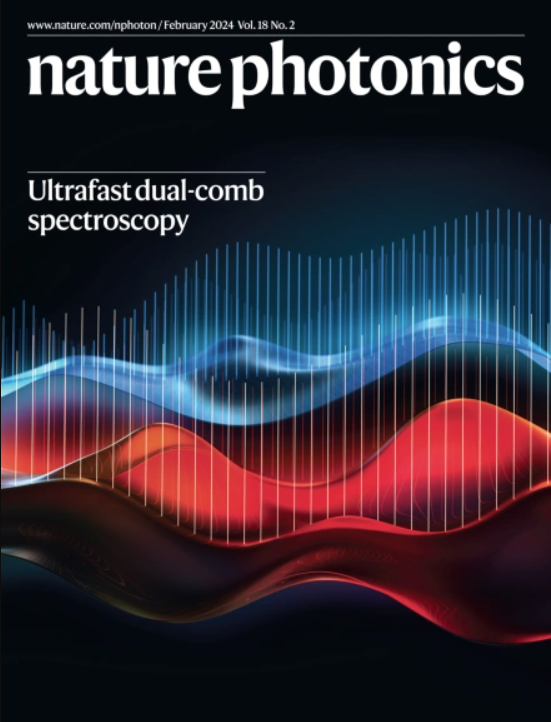Parallel photon avalanche nanoparticles for tunable emission and multicolour sub-diffraction microscopy
IF 32.9
1区 物理与天体物理
Q1 OPTICS
引用次数: 0
Abstract
Photon avalanche (PA) can generate upconversion luminescent emission that grows steeply as a function of excitation power, effectively exhibiting a high order of nonlinearity (N) that is attractive for applications ranging from photophysics studies to biophotonics. Besides the limitations in available material systems, PA is typically sustained by a single reservoir level, limiting the ability to modulate the chromaticity of the emission as well as leading to small values of N and large excitation thresholds. Here we report a parallel PA mechanism in holmium (Ho3+)-doped nanoparticles for tunable emission at room temperature. The intermediate 5I7 and 5I6 levels of Ho3+ serve as dual reservoir levels that create two parallel energy loops. This activates multiple emissive levels and enables red, green and blue PA emission under 965 nm continuous-wave excitation. By rationally engineering transition kinetics through controlling doping concentration and core/shell configuration, we demonstrate multicolour PA with large N values of 17–22 and mild excitation threshold of ~22 kW cm−2. Moreover, emission can be tailored from almost pure red to intense red, green and blue by modifying the host lattice and introducing additional cross-relaxation pathways by doping with Ce3+/Tm3+. When using the nanoparticles to label biological cells, we demonstrate multicolour imaging on a single-continuous-wave-beam microscope with lateral spatial resolution of 78 nm and 102 nm in the green–blue and red channel, respectively. These findings open the way for manufacturing nonlinear multicolour fluorophores for versatile optical and biological applications. Holmium doping endows upconversion nanoparticles with a dual-reservoir-level mechanism for parallel photon avalanche emission, enabling tunable chromaticity at room temperature, nonlinearity index up to 22 and spatial resolution for multicolour biological imaging down to 78 nm.


用于可调发射和多色亚衍射显微镜的平行光子雪崩纳米粒子
光子雪崩(PA)可以产生随激发功率急剧增长的上转换发光,有效地表现出高阶非线性(N),这对从光物理研究到生物光子学的应用具有吸引力。除了现有材料系统的限制外,PA通常由单一储层维持,限制了调节发射色度的能力,并导致N值小而激发阈值大。在这里,我们报道了一种在室温下可调谐发射的掺钬(Ho3+)纳米颗粒中的平行PA机制。中间的5I7和5I6水平的Ho3+作为双重水库水平,创造了两个平行的能量回路。这激活了多个发射水平,使965nm连续波激发下的红、绿、蓝PA发射成为可能。通过控制掺杂浓度和核壳结构,合理地设计转变动力学,我们获得了17-22的大N值和~22 kW cm−2的温和激发阈值的多色PA。此外,通过修饰主体晶格和通过掺杂Ce3+/Tm3+引入额外的交叉弛豫途径,可以将发射从几乎纯红色定制为强红色、绿色和蓝色。当使用纳米颗粒标记生物细胞时,我们在单连续波束显微镜上展示了多色成像,绿蓝和红通道的横向空间分辨率分别为78 nm和102 nm。这些发现为制造用于多种光学和生物应用的非线性多色荧光团开辟了道路。
本文章由计算机程序翻译,如有差异,请以英文原文为准。
求助全文
约1分钟内获得全文
求助全文
来源期刊

Nature Photonics
物理-光学
CiteScore
54.20
自引率
1.70%
发文量
158
审稿时长
12 months
期刊介绍:
Nature Photonics is a monthly journal dedicated to the scientific study and application of light, known as Photonics. It publishes top-quality, peer-reviewed research across all areas of light generation, manipulation, and detection.
The journal encompasses research into the fundamental properties of light and its interactions with matter, as well as the latest developments in optoelectronic devices and emerging photonics applications. Topics covered include lasers, LEDs, imaging, detectors, optoelectronic devices, quantum optics, biophotonics, optical data storage, spectroscopy, fiber optics, solar energy, displays, terahertz technology, nonlinear optics, plasmonics, nanophotonics, and X-rays.
In addition to research papers and review articles summarizing scientific findings in optoelectronics, Nature Photonics also features News and Views pieces and research highlights. It uniquely includes articles on the business aspects of the industry, such as technology commercialization and market analysis, offering a comprehensive perspective on the field.
 求助内容:
求助内容: 应助结果提醒方式:
应助结果提醒方式:


